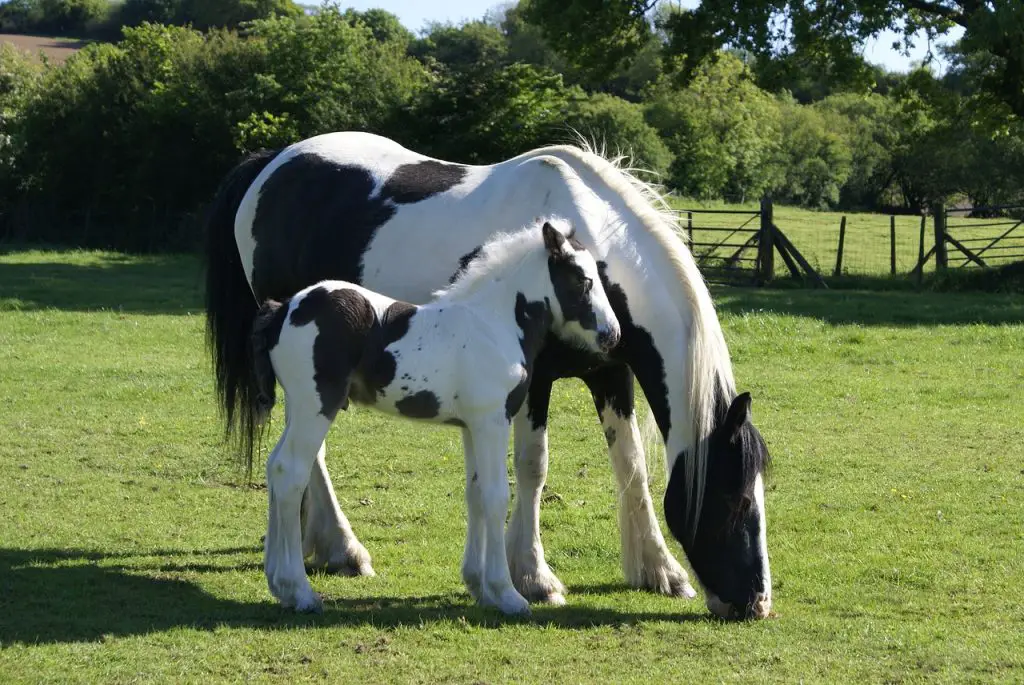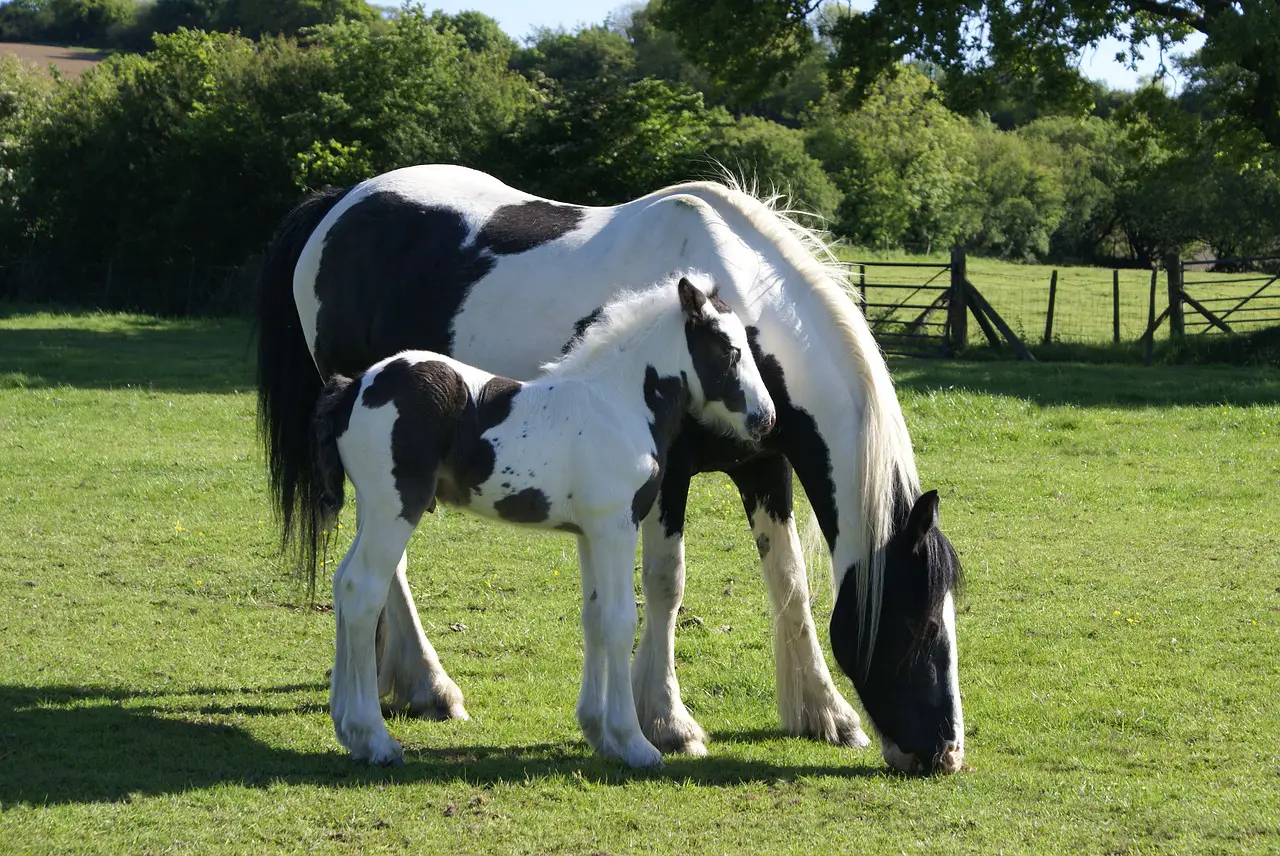Last Updated on February 21, 2022 by Allison Price
I was a huge fan of draft breeds growing up. I dreamed of riding and owning a Clydesdale.
The Gypsy Vanner was one of my favorite horse breeds and one of the smaller “draft horses”. It was love at the first sight.
I finally saw a Gypsy in person this year. It was at a fair, and I was there to see the miniature horse show. I had just purchased a mini mare and wanted to learn more about driving. Then I thought “Wouldn’t a miniature Gypsy Vanner something?”
Imagine a miniature horse with thick feathers and thick coat. It would be easy to handle, but it would pull harder than a regular mini. I joked with one of the miniature horse owners at the show and she agreed that she would like one. I thought I was crazy to even think about a miniature Gypsy.
Imagine my surprise when I googled “miniature Gypsy Horse” to find a large number of people who have worked on this breed for many years! It is truly amazing, so I decided to do some research and bring it to the attention of the public.

So I reached out to Melanie Block, the owner of Bellbottom farm in Illinois. She is also the administrator of the Mini Gypsy Horse facebook group. She was kind enough answer questions and provide photos of some of the stock being bred. ).
It all started with her children’s ponies. She was looking for “good, old-fashioned ponies” to give her children and couldn’t find them. She was so happy to find the Gypsy. She fell in love with the Gypsy instantly, just like me.
“In 2006, I visited Dennis Thompson in Florida and fell in love completely with the breed after meeting his mare Shampoo Girl as well as Gypsy King. I continued my search for pony-sized stock. There were very few people online talking about small Gypsy ponies. I found Pamela Renfro Dickey from Pennsylvania, who has the amazing Toymakker horse. I found the picture of the Tom Dooley Horse in UK around that time, a black pony with heavy feathers that has been an inspiration to my work.
That year, her farm was called Bohemian Gypsy Cob Ponies.
Her foundation stallion and her mare were both from Black Forest Shires, Gypsy Horses, who imported European breed-quality Cobs from Europe to North America.
Miniaturizing
According to the Traditional Gypsy Cob Association, the UK’s breed is divided into different sizes:
- Short, compact, and stocky ponies can pull flat carts up to 14.2hh.
- Cobs up to 15hh high and powerful are used for pulling heavy loads and living wagons.
- More than 15hhh Cobs with more Shire/Clydesdale blood, used for heavy loads or agricultural work
- Trotter Cobs are usually cross with standard-bred horses and used for racing in Sulky traps, sulkies, or road racing.
They have a category for small ponies in this instance, although they were originally closer to 12.2h. People weren’t thinking about a miniature horse.
The American Miniature Horse Registry in the United States has miniature horses in two height categories: horse up to 34 inches and horse between 34 and 38 inches. Block plans to create the Miniature Gypsy, which will be approximately 36 inches in height.
This is not an easy task. This takes patience and careful breeding. Block wants her offspring to look small but still have the Gypsy signature trait of heavy feathering. Block explains how Block is keeping the Gypsy blood while she breeds down.
I did create my own breeding program in order to create a mini-gypsy with Lex and three miniature horse mares of the AMHR size. I switched stallion every few years as I discovered smaller purebred stock (12.3 hand The Executive, then 11.3 hand Wyatt). This time I am refocusing my program. I use six purebred Gypsies and unrelated mares to produce my small stallions. I will strive to produce smaller, more feathered young stock. Six part-gypsy mares are also my responsibility and I am proud to have them.
Worldwide Effort
Block, like I, began to realize that she wasn’t the only one who had an idea for a Miniature Gypsy. Block discovered that many farms in Ireland and the United Kingdom were producing pony-sized, feathered stock. She created her Facebook group and was able connect with other enthusiasts. Many of these horses were mixed with Shetland ponies or other ponies from the United Kingdom.
She believed that ponies were involved in the creation and use of the Gypsy Vanner, as you often see them in the pony height range (under 14 years). As they can sometimes happen naturally, this helps breeders to find smaller horses. Block explains:
It is clear that Gypsy Vanner’s narrative states that native pony stock was used to “sweeten” the appearance of larger mares bred from coarse draft mares. The Dooley Horse was used on wagon mares in the 14-hand range and above. This was a great way to get the best Gypsy horses. We get smaller “throwbacks” [pony-sized offspring] by using the 14 hand horses. Because so many Cobs of higher quality Cobs from larger feathered breeds were being sold around the world, Romany/Tinker breeders began to concentrate on smaller ponies. The ‘Mini Gypsy Cob is a smaller version of the Cob. It can be used for up to 13 hands.
There are only a few small, beautiful Gypsies today that will be the future of the Miniature Gypsy Horse breed. Fred Walker, a British stallion named Valentino, has a 12hhh stallion named Valentino. Even more remarkable is the Galway Boy, which Joseph Delaney from Ireland just sold Christine Cantrill, Australia. He measures in at 9.2hh, which is 38 inches! He is the perfect example of a Gypsy Vanner’s looks.
The Future
Block is working towards the 36-inch mark but she stated that the best thing about what they are doing is creating variety for buyers.
“The great thing about the Mini Gypsy, is that there will always be a variety of sizes for any beautiful, kind, and useful work pony people desire, starting at 13 hands.
You may be asking yourself, “Can I breed my miniature mare to one these small Gypsy Studs?” Yes, it is possible.
To preserve the genetic traits and ensure that foals are healthy, breedings are being done carefully. A mare and her foal are not something anyone wants to lose. When it comes to breeding, size is very important.
Foal size is the most important issue. The foal size is important. Otherwise, there may be problems. Block recommends that you find a smaller stallion than your mare. A mare with Cob-like traits is also a good choice.
“Cobs are a breed that is strong, sturdy, and has large joints. Temperament is the most important thing in the end. My opinion is that a Gypsy Cob will not be born to someone who lacks a gentle, quiet temperament.
Elaine Heney offers horse courses
- Listening To the Horse – The Documentary By Elaine Heney and Grey Pony Films
- Shoulder In-&Out Training to improve balance, bend and topline development with horses
- More than 110+ Polework Exercises and Challenges to Download
- Dancing at Liberty & Creating a Connection with Your Horse (11 Lessons) – Grey Pony Films
Mini breeders and owners who have been breeding the “Arabian” 30 inch type for the showring may find it difficult.
“I believe in using mares at least 34 inches with generous pelvic structure, and a Mini Gypsy Stallion that is hopefully two hands shorter than the mare’s height. They should not have a large fetal increase in cross, and they rarely have increased birth risks. The mare that is half Gypsy Cob must be bred to a stallion in the same size range. This is because she may have a high growth gene. There will be more small stallions each year.


